Paris & the Ile-de-France
With 27 million visitors every year, the ‘City of Light’ needs little introduction.
Simply reached by air or high-speed train, it’s easy to take in its many motoring attractions during a holiday or business trip. France’s capital city is home to Rétromobile, one of Europe’s greatest classic car shows, and to the world’s most visited motor show, the Mondial de l’Automobile. It is also the starting point for many of the grandest tours and rallies, such as the Tour Auto and the Rallye des Princesses.
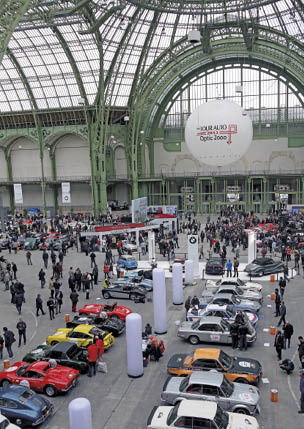
The start of the Tour Auto, in the magnificent setting of the Grand Palais.

Scrutineering for the Rallye des Princesses in the shadow of the Eiffel Tower. (Courtesy Richard Bord/Zaniroli Classic Events)
Paris is a great city to explore on foot: why not take a walk down the Champs-Élysées, originally home to the country’s first car showrooms, and look at the manufacturers’ displays, or visit France’s leading gallery of motoring art and specialist bookshops?
Outside the capital, the biggest highlight is the famous banked track at Montlhéry, which hosts several events for lovers of historic cars, from the Vintage Revival, through to the Youngtimers’ Club, for cars from the ’70s to ’90s. There are many more events throughout the year within an hour’s drive of Paris. You’ll find details of all these, and many less well-known attractions, in the following pages.

Contents
1. Collection de l’Aventure Automobile à Poissy (CAAPY)
2. Conservatoire Citroën, Aulnay-sous-Bois
3. Expo-musée Renault, Boulogne
4. Musée des Arts et Métiers, Paris
5. Pavillon Renault, Ile Seguin
6. Rétro Mobile Drouais, Dreux
7. Mondial de l’Automobile, Paris
10. American Car Club de France (ACCF) Festivals
11. Autodrome Heritage Festival, Montlhéry
14. Exposition Concept Cars, Paris
15. Locomotion en fête, La Ferté-Alais
16. Rallyes de Paris GT et Classic
18. Traversées de Paris en anciennes
20. Youngtimers Festival, Montlhéry
26. Citroën C42 & DS World, Paris
27. Doc’Auto, Paris
29. Librairie Passion Automobile, Paris
30. Mercedes-Benz Center, Rueil-Malmaison
31. Mercedes-Benz Gallery, Paris
33. Osenat auctions, Fontainebleau
35. Le Rendez-Vous Toyota, Paris
36. Coupes de Printemps, Montlhéry
37. Vintage Revival, Montlhéry
38. Autodrome de Linas-Montlhéry
39. Circuits Automobiles LFG, La Ferté-Gaucher
40. Circuit JP Beltoise, Trappes
41. Circuits de l’Ouest Parisien, Dreux

Rétromobile, the grandest classic car show in France. (Courtesy Comexposium)

Collection de l’Aventure Automobile à Poissy (CAAPY)
Few car factories have had such a varied past as that at Poissy. Originally built by Ford in the 1930s, it was taken over by Simca in 1954, who expanded and modernised the plant. During the 1960s, Simca was progressively taken over by Chrysler, itself acquired by Peugeot in 1978. After briefly re-launching the Talbot brand in the 1980s, the PSA group has continued to develop the site, which now produces such small cars as the Peugeot 208 and Citroën DS3.
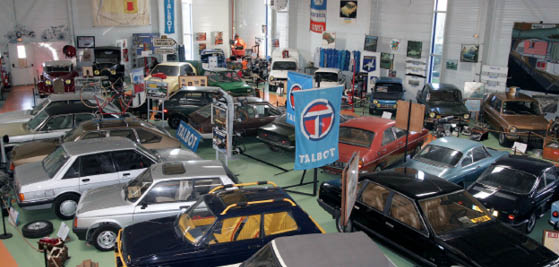
Overview of the Talbot area of the museum. (Courtesy L’Aventure Automobile à Poissy-CAAPY)
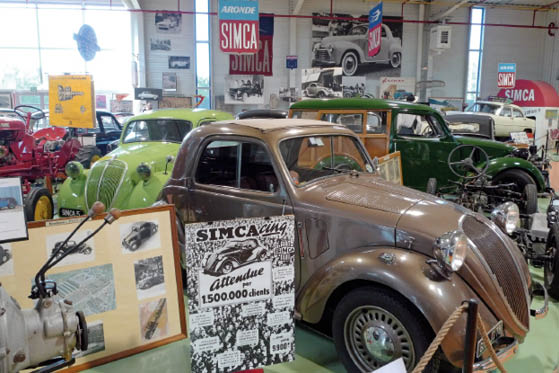
Simca 5 display, with cutaway chassis and period advertising
This diverse history is reflected in the museum. Opened in 2002 and run by enthusiasts with support from Peugeot, it houses 70 cars from the different manufacturers whose cars were built there. Beginning with a Ford F472A from 1946, there is a fine display of Simca models from the ’50s and ’60s. Highlights include a Simca 9 Figoni and a 936 minicar prototype, together with an imposing Vedette Présidence. The Talbot years are represented by a Talbot Sunbeam Lotus, rallied by Guy Fréquelin and Jean Todt, and a now rare Tagora saloon. Contemporary accessories and publicity materials complete the displays, together with an exhibit showing a Peugeot 309 being built.
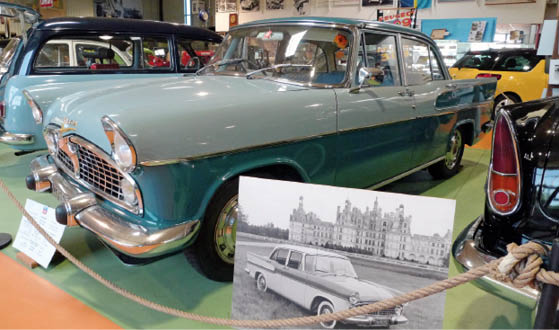
Simca Chambord with period photograph in front of the château at ... Chambord.
Practical Information
- Opening Information: Restricted opening hours, currently Monday afternoon and Saturday only (see website); groups by appointment at other times
- Address: 212, boulevard Pelletier, 78955 Carrières-sous-Poissy
- Train services: RER line A or SNCF to Poissy, then 15-minute walk
- GPS Coordinates: 48.94217 N, 2.03852 E
- Website: www.caapy.net
- Telephone Number: +33 (0)1 30 19 41 15 (during opening hours)
- Email: caapy@peugeot.com


Conservatoire Citroën, Aulnay-sous-Bois
For any Citroën enthusiast, this collection should be at the top of the list of places to see in France. Although the factory at Aulnay closed in 2013 after 40 years’ production, Citroën has committed to keeping this site open. Its Heritage staff personally lead tours of the collection (in English and French), so you’ll need to book in advance.
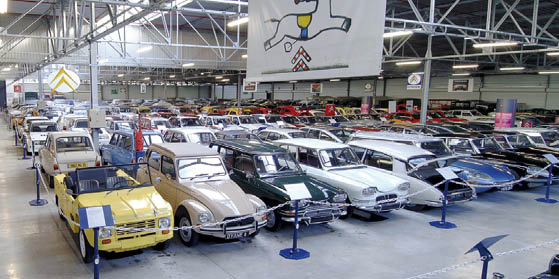
Citroën’s 2CV family (Ami, Dyane and Méhari) with period advertising poster by André François. (Courtesy Citroën Communication/N Zwickel)

Citroën BX4TC rally cars and RE-2 helicopter. (Courtesy Citroën Communication/Jérôme Lejeune)
Originally opened in 2001, the Conservatoire brings together more than 250 cars from the manufacturer’s sites around Paris and in Rennes, and also from Spain and Portugal. Citroën’s factory at Slough, west of London, is remembered with British-built 2CV and Traction Avant models. Many of the cars were taken straight from the production lines, but there are some extraordinary prototypes and one-offs, too, such as the 1982 Visa Lotus, effectively a Lotus Esprit Turbo powertrain under a modified Visa body. An RE-2 helicopter from 1975 marks Citroën’s take on personal transportation of the future, as well as an attempt to diversify its business.
The Conservatoire also houses Citroën’s extensive archives, and visitors can buy thematic dossiers for nearly 20 different models, as well as a personalised document set for every Citroën car built from 1919-90.

Citroën Traction Avant and early 2CV models. (Courtesy Citroën Communication/N Zwickel)
Practical Information
- Opening Information: Open by appointment only – book in advance
- Address: Boulevard André Citroën, 93601 Aulnay-sous-Bois. Use Visitors’ entrance, gate 1
- GPS Coordinates: 48.961151 N, 2.488276 E
- Website: www.citroen.fr/conservatoire-citroen
- Telephone Number: +33 (0)1 56 50 80 22
- Email: martine.darblade@citroen.com or conservatoire@citroen.com


Expo-musée Renault, Boulogne
This modest building in the Paris suburb of Boulogne is run by an association committed to preserving Renault’s history. There are no actual cars on show, but a series of exhibition rooms tell the story of the Renault family, and the industrial and social history of the company’s factories, many of them originally in Boulogne-Billancourt. The François Szisz room, named after the winner of the first ACF Grand Prix in 1906, focuses on Renault’s competition successes, its record-breaking cars, like the ‘Étoile filante’ and its expeditions to Africa and Alaska. The exhibits are rather stuffy, but there is a wealth of information here. The association also manages an archive of Renault’s history, and hosts regular talks and showings of period films for its members and visiting clubs.
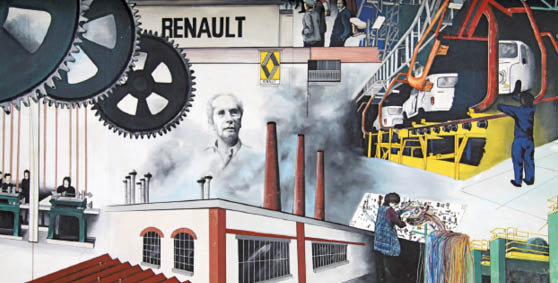
Mural depicting the history of Renault’s factories in Boulogne-Billancourt.

The Louis Renault room, telling the story of Renault during the First World War.
Although Renault’s outstanding collection of several hundred historic cars, stored at its factory at Flins, is sadly not open to the public, this museum and the Pavillon Renault, both in Boulogne, and L’Atelier Renault on the Champs-Élysées, all offer visitors to Paris the chance to learn more about Renault’s history and its latest models. Renault Classic also regularly loans its cars to exhibition organisers across the country.
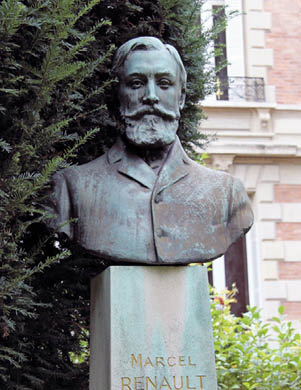
Bust of Marcel Renault, one of the company’s founding brothers, in front of the museum.
Practical Information
- Opening Information: Tuesday and Thursday afternoons only (closed August); groups should book in advance
- Address: 27, rue des Abondances, 92100 Boulogne-Billancourt
- Metro Line: Line 10, Boulogne-Pont St Cloud
- GPS Coordinates: 48.8453663 N, 2.2299225 E
- Website: https://sites.google.com/site/histoiregrouperenault/expos/expo-musee
- Telephone Number: +33 (0)1 46 05 21 58
- Email: histoirerenault@aol.com or shgr.communication@gmail.com


Musée des Arts et Métiers, Paris
Established by the Abbé Grégoire in 1794 – and completely renovated in 2000 – the Musée des Arts et Métiers is Paris’ oldest scientific museum. It displays more than 3000 inventions, with highlights including the Lumière brothers’ first camera and Foucault’s famous pendulum. The exhibits are set out in seven thematic areas, including mechanics and transport, and English-speaking visitors are well catered for, thanks to English leaflets and audioguides.

A replica of Leyat’s Hélica, seen here on the track at Montlhéry.
The museum’s transport section is grouped into three parts, covering steam-powered transport from 1750 to 1850, mass transportation from 1850 to 1950, and individual transport from 1950 onwards. The museum is best known for Cugnot’s 1770 steam-driven dray, the world’s first self-propelled vehicle, and for Leyat’s curious propeller-driven Hélica from the early 1920s.
Make sure you don’t miss the additional transport display in the former church: a multi-level metal structure which seems strangely out of place in this historic setting. As well as the Hélica, you’ll find Léon Bollée’s L’Obéissante steamer from 1873, a splendid 1935 Hispano-Suiza K6 coupé de ville and, rather incongruously, a 1983 Renault RE40 F1 car driven by Alain Prost. There is also a huge engine built in 1892 by Rudolf Diesel himself.

The main entrance to the museum.
Practical Information
- Opening Information: Tuesday-Sunday 10am-6pm and Thursday evenings until 9.30pm; closed 1 May & 25 December
- Address: 60, rue Réaumur, 75003 Paris
- Metro Line: Lines 3 & 11, Arts et Métiers
- Bus Services: Lines 20, 38, 39 & 47
- GPS Coordinates: 48.865842 N, 2.355481 E
- Website: www.arts-et-metiers.net
- Telephone Number: +33 (0)1 53 01 82 00
